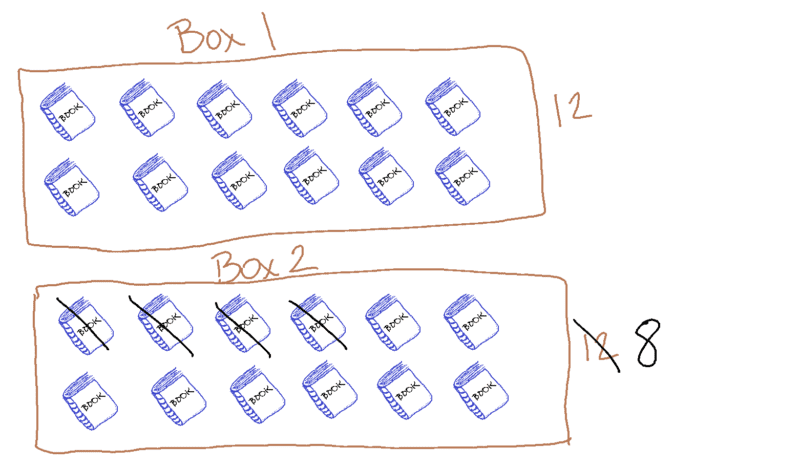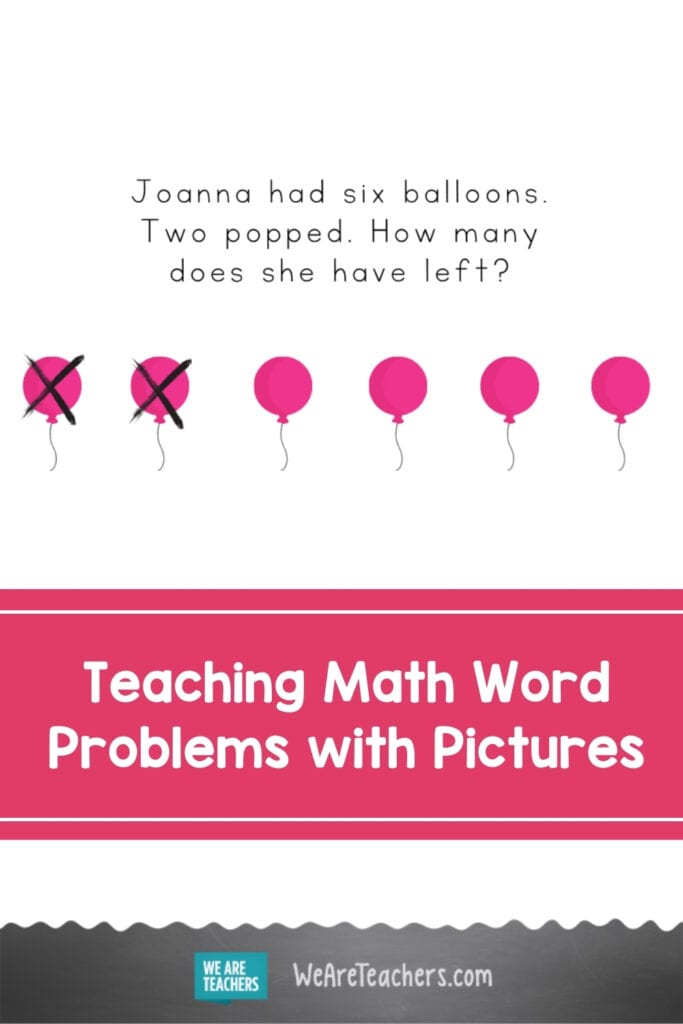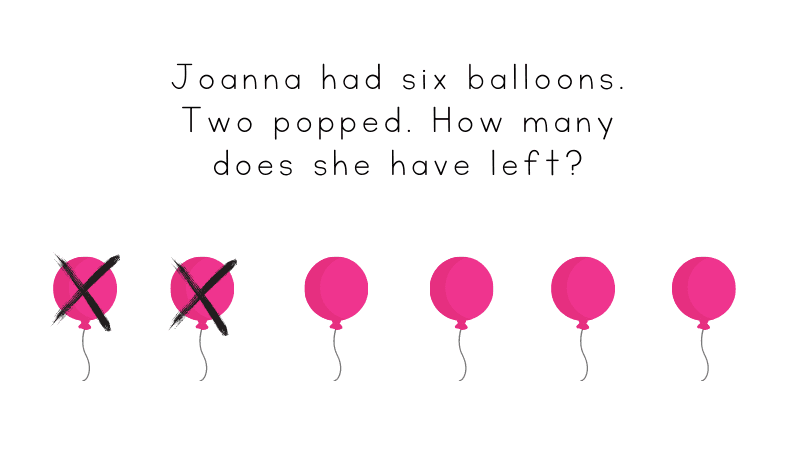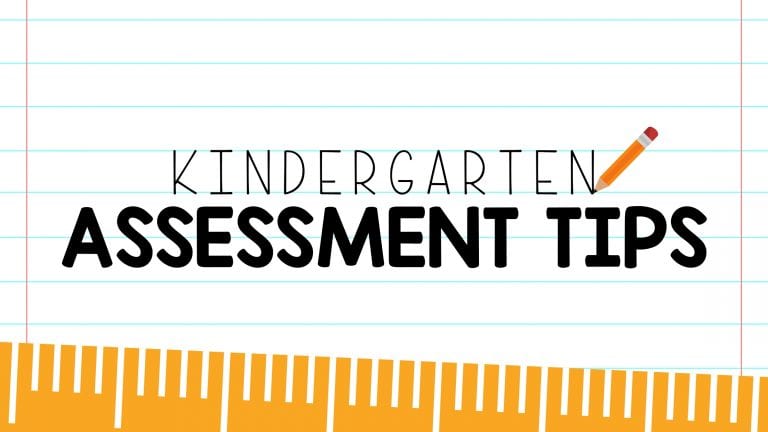If you google word problem jokes, this one will pop up a lot:
“If you have 4 pencils and I have 7 apples, how many pancakes will fit on the roof?
Purple, because aliens don’t wear hats.”
It’s hilarious because it’s true! Many of our students see nonsense in word problems. They not only have to figure out what the word problem is asking them to do, but then they have to actually solve it. It’s a process. However, if we want them to internalize the concept, not just the numbers, pictures can help! Visuals can help students comprehend meaning when the words aren’t making sense to them. Don’t underestimate the power of teaching word problems with pictures. Here are a few easy ways to incorporate visuals into everyday math:
The power of “acting it out”
Before you go from manipulatives to drawing, try having students act out problems. If the problems involve eating, bring in food and have a student actually act like they are in the story problem. If the problem involves a specific number of boys and girls, have that many students get up and show the class what is going on in the problem. Taking this step will help students visualize the problem and think about the actions rather than just guessing if they should add, subtract, multiply, or divide.
[contextly_auto_sidebar]
Getting ready to draw
When you’re ready to start solving word problems with pictures, follow Jan Rowe’s steps:

- Read the entire problem: Get all the facts and underline keywords.
- Answer the question: What am I looking for?
- Draw a picture or diagram: Visualize as a real-world situation.
- Solve the problem: Set up the equation and solve.
- Check your solution: Is this answer reasonable?
Drawing as a step of the process
Visual representations are a good starting point for word problems because it is an intermediate step between language-as-text and the symbolic language of math. Drawing lowers the affective filter because it can be less stressful. We aren’t stepping straight into that equation; we are just drawing to figure out what the question is actually asking us. Remind students that we are not in art class. It is perfectly OK for your math pictures to be just scribbles as long as you know what they represent. Another great perk of the “Draw a Picture” strategy is that you, as a teacher, can really step inside the student’s brain to see how their mathematical brain works. Encourage labeling so that you can catch misconceptions right away. These drawings can lead to great math talk conversations, which build that academic language that we all want to hear.
Problem:
Jayden had two boxes of books with twelve books in each box. He gave four books to his sister. How many books did Jayden keep for himself?
Draw a picture:

Try photography instead of drawing
Story problems are grounded in reading. Photograph Math is an activity that can help visual learners grasp the math skill first, then add in the language. All you’ll need is a camera (or phone) to take pictures. Here’s how it works:
- Students brainstorm the ways in which, and the places where, they use math.
- They stage a photograph representing one of these ideas.
- Students write their own real-life word problems to go with their posed photograph(s).
Examples:
- Students take a photograph of the menu inside the cafeteria. They write problems that help them figure out how much money they need to get specific lunches, snacks, or drinks. Extension: Think about how much you would need to get a snack every day, for a week, etc.
- Someone might take a photo of a number on a library book. Then try to figure out what value that number would have based on the number of digits and round the number to the nearest whole, tenths, or hundredth.
- Students take a photo of your stash of whiteboards markers. They could write problems about the amount of each color you have. They may choose to think about what happens if another teacher borrows a certain number of markers, etc.
Photograph math can help students to start thinking like a mathematician in all aspects of life. If students begin to see the math around them, then they can truly begin to comprehend the story problems that we present to them in class.
Read a math picture book
Remember when I said story problems are grounded in reading? Why not use actual stories? Children’s picture books can provide a rich context from which to begin mathematical investigations. As students see math concepts play out in stories and illustrations, they are engaged and better able to construct meaning. Seeing the problem-solving process in action through a book can serve as a model for students when they go off on their own to solve problems. Here is a list of 16 picture books about math.
Assign math as picture prompts
Consider starting each week with a relevant picture prompt. Sometimes, the picture is of a mathematical error we came across in real life. The challenge to students is to figure out the mistake. Other times, we simply provide an image and challenge students to come up with a story problem to accompany it. Giving students ownership of these problems can strengthen and extend their comprehension of story problems.
Examples:
- Put up a sign of a price mistake in a store. Then write on the board: “Ms. Caudill saw this sign at Walmart this weekend and laughed. Why? How might you fix it?”
- Show students the following prompt: Write a story problem using the photo and the following word bank: apples, tomatoes, sweet potatoes, pound, gallon, farmer’s market.
The truth is, story problems are challenging for all students. We have to find ways to make the story problems relative to students’ lives if we want them to succeed.
How do you teach word problems with pictures? Share in the comments below.
Want even more strategies for teaching word problems? Check out 14 Effective Ways to Help Your Students Conquer Math Word Problems.
Want more articles like this? Make sure to sign up for my weekly newsletter for third grade teachers!


